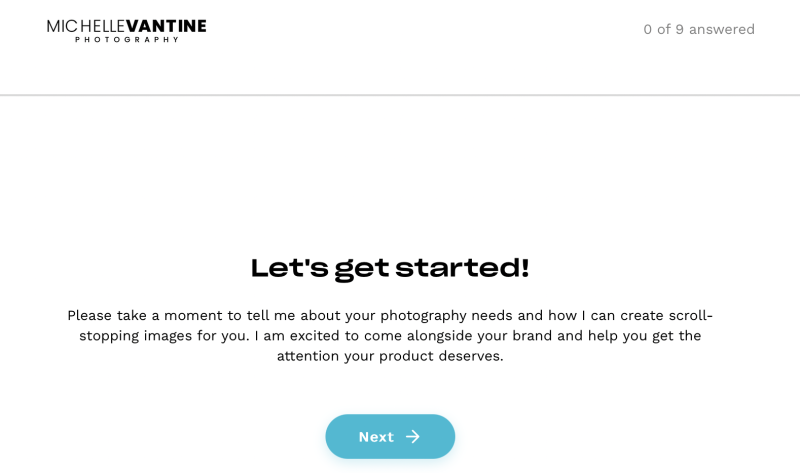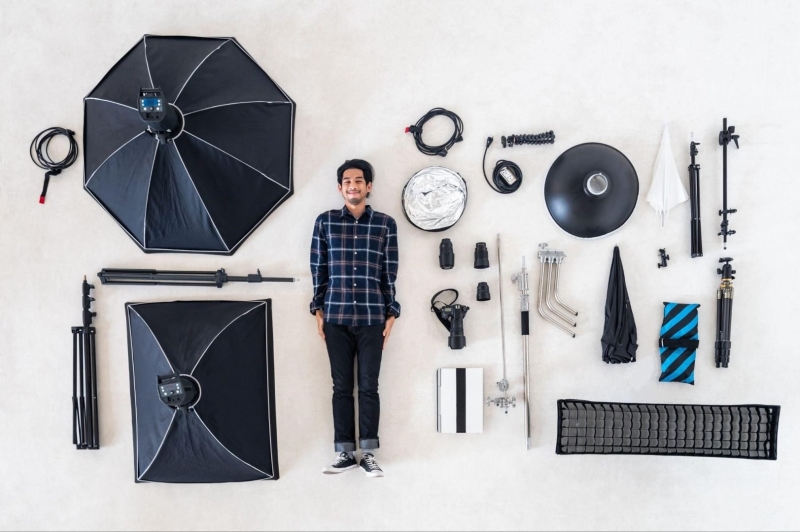Contents
Do you want to be the most re-booked, referred, and absolutely adored photographer in your space? Being a skilled photographer is just not enough in this competitive industry. To be the most re-booked photographer on the block, it has to be more than the basics: good communication, project management, and… yawn. You know all that. Let’s dive into some client retention strategies which you may have never considered and some practices that will boomerang brands back to you over and over.

Image by Michelle VanTine Photography
Streamline Your Photo Shoot Planning Process
People are busy, overworked, understaffed, and just plain overwhelmed. They’re often juggling more than they have the mental space for. When clients find a photographer who will get the job done effectively and deliver exactly what they want on time, they will never feel a desire to look for someone else.
Understand the Client’s Requirements
But how do you achieve this? We aren’t mind readers, and if you’ve been in the game for a while, you have quickly learned that sometimes clients don’t even know what they want. Or they do, but they don’t know how to say it. Or worse, they think they’ve said it, and it’s buried in a seven-word sentence at the bottom of a 43-email chain.
Getting to the bottom of it, then, depends almost entirely on communication and collaboration, a point emphasized by Hanoi-based photographer Tim Gerard Barker.
For me, it’s about offering great service and being highly attentive to detail right from first contact and all the way through to delivery. I prefer a collaborative experience when on assignment, and the clients that keep coming back to me are usually those who appreciate the effort that I put into understanding the brief, and the planning that I do during pre-production to bring their vision to life.
Usually, by the time a shoot comes around, the client and I have developed a pretty good connection, and this leads to confidence from both sides that we are going in the right direction. The collaborative experience usually continues during the shoot, and when it’s at its best, it usually leads to great results. When the experience is great for the client and myself for the duration of the project, it usually leads to repeat business.
The secret to hitting a home run every time is the process on the front end, and that’s why the pre-production phase is everything. The photos you deliver are only as strong as the planning that came before them. A well-managed process sets the foundation for everything that follows: timelines, expectations, creative alignment, and even a client’s happiness.
[Related Reading: Yes, You Can Get Photography Clients Without Social Media]
My Process
Here are a few practices you can use and make your own. It provides structure that is flexible enough to feel personal but clear enough to guide the process.
1) Have the Client Fill Out a Brief and Painless Questionnaire
I use the form on my CRM platform Bloom. It has a modern-looking, multiple-choice or short-answer form that the client clicks through. It bypasses the problem of clients opening a long questionnaire and feeling overwhelmed.

2) Require Five to Eight Inspirational Images, and Three “Crush” Brands
If you haven’t received a thorough creative brief, ask for examples. Since not every client is effective in communication, requesting these visuals can provide a feel for the mood, tone, modernity, and aesthetic they want. When I ask for three “crush brands,” I ask the client to provide three brands that display the aesthetic they want for their images. It doesn’t have to be the same product; it’s more about the branding. For example if the client sends me Dove soap, I’m observing soft light, heavy diffusion, softly falling shadows, natural editing. If they send me Dr. Jart, I’m observing bold colors, hard light, strong shadows, a focus on geometry and most likely little to no diffusion on the lighting.

3) Follow Up the Questionnaire With a 15-Minute Video Call to Review the Information
Make sure you understand what they want. Ask a lot of questions. “What did you like about this image?” When you look at one of their brief images, you may think, “I see that they want hard light. I’ll probably shoot bare bulb with a silver bounce card.”

ImaImage by Michelle VanTine Photography
One question I always review with clients is whether they want hard light (left) vs. soft light (right).
But upon digging into it, you discover that they “hate the flash look” but like how the bottles are stacked upon each other. Get the information, and go through it without making any assumptions. Ask what they like and don’t like about each image.
[Related Reading: What to charge for food photography (and other business tips)]
Delight But Don’t Over-Deliver
Overdelivering is risky business, and I’m not on board with it. You don’t want to give your client the expectation that you deliver more than you are contracted to. A client holding their breath for free work is not an expectation you want to create. Instead of overdelivering, try this trick.
Take an extra shot that the client never sees. It could be in correlation with an upcoming holiday, or a variation on an image you were working on for delivery.

Send it to them weeks or even months later with a kind email. “Happy client appreciation day! Thank you for continuing to trust me with your imagery, I’m grateful to be part of the team.”
Surprises add major deposits into your trust fund (the only kind that pays in referrals and repeat business).
Smile Through the Screen (or Let ChatGPT Do It for You)
Energy never lies. Ever. And your energy is a factor in client satisfaction, retention, and referrals because the simple truth is that people love to work with nice people. It’s that basic. So much so, in fact, that Robert Sutton’s The No Asshole Rule won multiple awards and quickly lined bookshelves worldwide. Similar findings are outlined in a study by American Express, which found 33% of customers will consider switching companies after just one instance of poor customer service. We all like to work with people who bring positive, solution-oriented, bright energy to the team.
Alexis Korman, co-founder of Big Easy Bucha, shared her perspective on selecting vendors for her nationally distributed brand.
“In addition to checking off boxes like on-time delivery, consistency in work product, and timely communication, there’s a human element at play when it comes to client retention. At the end of the day, we tend to choose people we enjoy working with; and in creative fields, who delight and surprise us.”
Having said that, even my little zen radiant self has been ready to unleash a piece of my mind in an email or two. Whether it’s a scope-of-work creep or a rude tone, people can get under the skin of even the most well-intentioned photographer.
I heard in a podcast that when a client is being unreasonable, I should close my eyes, imagine their face with a big dollar sign on it, take a deep breath, and continue the correspondence. It sounded outrageous, but somehow I’ve come back to the shockingly effective trick over and over.
When you’ve been dealing with that one client who has exacerbated you to the limit of your patience and you find yourself winding up for a “per our last email…” red-flag yourself! Try this trick: write the email you want to write and run it through ChatGPT. Give your AI accountability partner the directive to rephrase your email to be more professional and to remove any hints of passive aggressiveness.
It’s surprising how ChatGPT has rephrased my emails to be diplomatic and solution-focused without compromising on any of my boundaries. You don’t even have to type out the email anymore. Chat GPT has a voice record function that allows you to dictate your request. You’re effectively all out of reasons to be rude- Chat GPT just turned your “per our last email” into a “let’s work together to find a solution.” *digital smile.
The One Question Every Photographer Should Ask After Delivering Images
I struggle to do this every time. I do. But I make myself write it, and my clients love me for it. In my image delivery email, I always include this one sentence.

“Is there anything else I can do to make this shoot a homerun for you?”
I don’t like to ask it, because I’m scared of that one client who will abuse the offer. To my surprise they usually thank me—and often mention how much they appreciate my dedication. When we include sentences like this, we show clients that their satisfaction matters, building trust in the process. When a client knows that you are a photographer they can trust, they’ll keep coming back.
Style Matters, Too
You can be the easiest photographer to work with, have the smoothest process, and still not get hired if your style doesn’t resonate. That part matters, too.

Clients want consistency. And they want a style that works for them again and again. That’s why cultivating a recognizable aesthetic goes from being an artistic choice to a business asset. When clients know what they’ll get from you, whether it’s crisp product shots or rich and shadowy portraits, you become a safe bet. And in a world full of unknowns, being a reliable creative voice is gold.
Tim put it best:
It’s important to have a style that stands out. My work is very clean, and each image is considered during both shooting and post-production, so some clients come back to me so that the style of imagery remains consistent from one campaign to the next.
Define a client’s look, and that one-off job can turn into a long-term partnership.
Closing Thoughts
Client satisfaction comes down to many factors—clear communication, setting expectations, delivering on time, and all the other basics. But you already know that—and this article has to end sometime. No one likes listening to me that long!
The bottom line is that you want loyal customers who enjoy you and trust you. Studies have shown that loyal customers are 5 times as likely to repurchase, 5 times as likely to forgive, 4 times as likely to refer, and 7 times as likely to try a new offering.
You know what that means? More happy people who appreciate you, refer you, and want to give you money to do what you love! As a photographer, the days between shoots can feel mundane—emails, briefs, and video calls. Not exactly a creative’s dream. But these in-between days are what truly shape client satisfaction and loyalty.
Peter Hurley, author, educator, and recent recipient of the 2024 Professional Photographer Achievement Award, expressed his greatest value as a photographer:
“The images we produce as portrait photographers are simply a byproduct of the experience that we had the opportunity to give someone. Make sure every second in front of your camera counts.”
When I read strategy articles, I always notice one missing question: is the skill there? As a former Fine Art teacher, I can’t help but remind photographers that no strategy will ever compensate for a lack of skill. Lighting, retouching, creativity, AI resources—these must be the foundation of any success strategy.
Here’s the reality: when you’re truly skilled, you’re competing with a dozen photographers, not hundreds.

But in a saturated market, talent alone won’t cut it. The hard truth? Less talented photographers sometimes out-book the most brilliant artists. At the end of the day, success isn’t just about mastering your craft—it’s about mastering the whole business of photography. Nail both, and you don’t just survive. You dominate.

